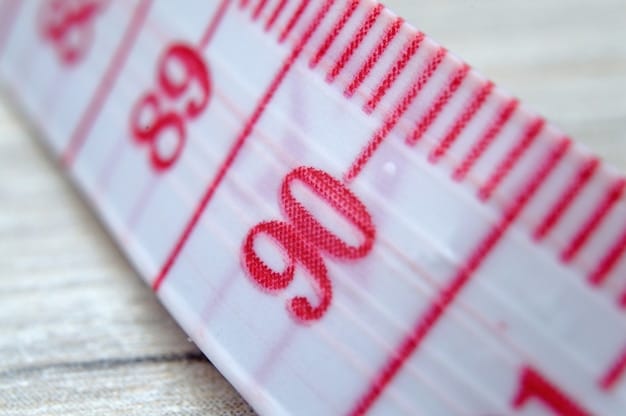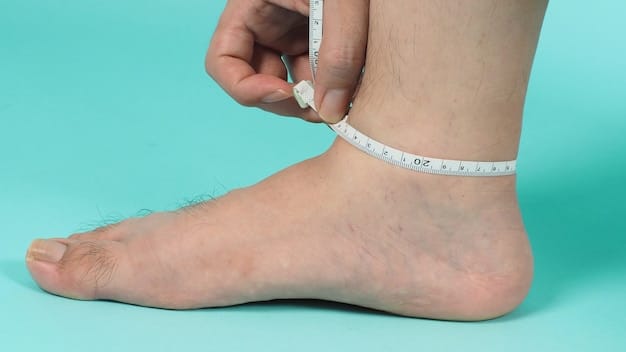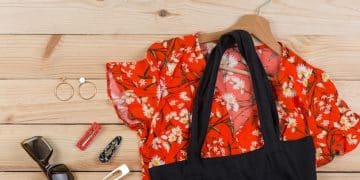Decoding Japanese Size Charts: A US Shopper’s Guide to Avoiding Returns in 2025

Navigating Japanese sizing for clothing and footwear can be complex due to significant differences from US standards, making it crucial for US shoppers to understand these variances and conversion methods to prevent common fitting issues and reduce the need for returns.
Embarking on the journey of international online shopping offers a thrilling array of unique products, from cutting-edge fashion to intricate homeware. However, for US shoppers eyeing items from Japan, a significant hurdle often emerges: the enigmatic world of Japanese sizing. This guide on Decoding Japanese Size Charts: A US Shopper’s Guide to Avoiding Returns in 2025 aims to demystify these discrepancies, providing actionable insights to ensure your purchases fit perfectly, saving you time, money, and the hassle of returns.
Understanding the Basics of Japanese Sizing
Japanese sizing, unlike the standardized systems often found in the US, frequently stems from different measurement philosophies and body types. What might be a “medium” in an American brand could correspond to a “large” or even “extra large” in a Japanese counterpart. This fundamental difference means that simply ordering your usual size is a recipe for disappointment, an issue we’re addressing head-on for 2025. It’s often not about one system being “smaller” than the other, but rather different points of reference for various body measurements.
The cultural emphasis on precise fit and meticulous craftsmanship in Japan significantly influences how garments are sized. Many Japanese brands design clothes with a slimmer, more tailored silhouette in mind, reflecting general aesthetic preferences. This means that while a US “Small” might offer a relaxed fit, a Japanese “Small” is typically engineered for a much closer body contour, particularly around the shoulders, chest, and waist. Moreover, leg lengths and sleeve lengths can vary considerably, necessitating careful checks.
Common Measurement Units and How They Differ
One of the primary challenges for US shoppers is the discrepancy in measurement units. While the US primarily uses inches for clothing and shoe sizing, Japan, like most of the world, adheres to the metric system (centimeters and millimeters). This immediate conversion requirement can be a source of error if not handled meticulously. It’s not just about converting inches to centimeters; it’s about understanding how those measurements translate into actual garment dimensions relative to your body.
- Apparel Measurements: Japanese clothing sizes often reference specific bust, waist, and hip measurements in centimeters. Unlike some US charts that might provide ranges, Japanese charts tend to be more precise, reflecting the exact garment dimensions or the body measurements they are designed to fit.
- Footwear Measurements: Japanese shoe sizes are typically given in centimeters, representing the length of the foot. For instance, a shoe size of “24” indicates a foot length of 24 cm. This can be a significant departure from US shoe sizing scales, which are less intuitive about direct length correlation.
- Headwear and Accessories: Even items like hats and gloves have precise metric measurements. Hats, for example, are almost always sized by head circumference in centimeters, offering a more accurate fit than the S/M/L categories often seen in the US.
Understanding these fundamental unit differences is the first critical step in overcoming sizing challenges. Always have a reliable conversion tool or chart at hand. Rather than guessing, take precise measurements of your own body in both inches and centimeters, and then compare them directly to the brand’s specific size chart. This proactive approach minimizes the risk of receiving an item that is either too tight or too loose, allowing for a smoother shopping experience.

Beyond numerical conversions, it’s essential to consider the “fit philosophy” of the brand. Some Japanese brands, particularly those catering to subcultures or specific fashion trends, might intentionally offer oversized or extremely fitted garments. Reading product descriptions carefully for terms like “slim fit,” “oversized,” or “relaxed silhouette” can provide crucial context. Don’t assume a baggy look in an image translates to a flexible size; it might be an intentional design choice for a specific size.
Navigating Japanese Clothing Sizes: A Deep Dive
When it comes to clothing, the nuances of Japanese sizing extend beyond simple numerical differences. Japanese garments are often designed with a specific body type and aesthetic in mind, leading to variations in length, sleeve dimensions, and overall cut. For US shoppers, this means focusing on key measurements rather than relying solely on letter sizes like S, M, L.
Tops and Outerwear: Chest, Shoulder, and Sleeve Length
For shirts, blouses, jackets, and coats, three measurements are paramount: chest circumference, shoulder width, and sleeve length. Japanese designers typically prioritize a snug fit around the shoulders and chest to create a sharp silhouette. If these areas are too tight, the garment will be uncomfortable and restrict movement. Sleeve lengths can also be a common point of contention; Japanese sleeves might fall shorter or have a different cuff design than what US shoppers are accustomed to for their height and arm length.
- Chest Circumference: Measure around the fullest part of your chest. Compare this directly to the garment’s stated chest measurement, giving yourself a little allowance for comfort, especially for outerwear.
- Shoulder Width: Measure across your back from shoulder seam to shoulder seam. This is where many US shoppers encounter issues, as Japanese shoulders tend to be narrower. A well-fitting shoulder seam is crucial for the garment’s overall appearance and comfort.
- Sleeve Length: Measure from the center back of your neck, over your shoulder, down your arm to your wrist. Compare this to the advertised sleeve length. Remember that some Japanese styles might feature shorter bracelet-length sleeves by design.
Always check if the size chart provides “body measurements” or “garment measurements.” Body measurements indicate the range of body sizes the garment is intended to fit, while garment measurements represent the actual dimensions of the clothing item itself. Knowing this distinction helps you choose whether to aim for a snug or a looser fit, based on your preference and the garment’s intended style.
Bottoms: Waist, Hips, and Inseam
Pants, skirts, and shorts can be particularly tricky due to the multiple dimensions involved. The waist measurement in Japan is often given in centimeters, and it typically refers to the garment’s actual waist measurement, not necessarily where your “natural” waist sits. Hip measurements are also crucial, especially for styles that are designed to be fitted through the hip and thigh area.
The inseam, or inner leg length, is another common area of difference. Japanese fashion often features different leg lengths that might appear shorter than typical US styles, even for someone of average height. It is always best to measure your preferred inseam on a pair of pants you already own and love to ensure a good fit.
For jeans, some Japanese brands use traditional denim sizing (e.g., W28, W30), which can be similar to US waist sizes, but these should still be cross-referenced with actual centimeter measurements to account for different rises (how high the waist sits on your body). A low-rise Japanese jean might sit differently than a low-rise US jean, impacting both waist and hip fit.
Japanese skirts and dresses often emphasize structured silhouettes. Pay close attention to waist and hip measurements as well as overall length from waist to hem. Many Japanese dresses are designed to hit above the knee or at mid-calf, which may be different from standard US lengths for similar styles. Always read the product descriptions for specific length details and visualize how that length will translate to your height.
Demystifying Japanese Shoe Sizing
Japanese shoe sizing is refreshingly straightforward once you grasp the fundamental principle: sizes are given in centimeters, directly corresponding to the length of your foot. This direct measurement system eliminates much of the guesswork associated with US shoe sizes, which are based on arbitrary scales. However, ignoring width considerations can still lead to uncomfortable fits.
Measuring Your Foot for Accuracy
To accurately determine your Japanese shoe size, you need to measure the length of your foot in centimeters. It’s often best to measure both feet, as one might be slightly larger than the other, and always use the measurement of the larger foot. Stand on a piece of paper, trace the outline of your foot, and then measure the distance from your heel to your longest toe.
- Place a piece of paper on a hard, flat surface against a wall.
- Stand on the paper with your heel firmly against the wall.
- Have someone mark the tip of your longest toe on the paper.
- Measure the distance from the edge of the paper (where your heel was) to the mark in centimeters. This is your foot length.
- Some retailers might also provide width measurements. If so, measure the widest part of your foot (the ball of your foot) and compare it.
Japanese shoe sizing generally does not incorporate width into the primary number, unlike some US systems where “W” or “N” might denote width. While most Japanese shoes are designed for an average foot width, some specialized brands or styles might offer options for wider or narrower feet. If you have particularly wide or narrow feet, seeking out brands that specify width options or reading reviews about fit can be crucial.

Remember that different shoe styles can also impact fit. A pointed-toe heel will fit differently than a round-toe sneaker, even if the numeric size is the same. Always consider the shape of the shoe and whether it aligns with the natural shape of your foot. For example, some dress shoes might have a narrower toe box, requiring a slight size adjustment or a focus on specific measurement comparisons.
Converting US Shoe Sizes to Japanese Sizes
While direct foot measurement is the most accurate method, many online conversion charts exist to help translate US shoe sizes to Japanese centimeters. However, these charts should be used as a guideline rather than an absolute rule, due to variations between brands and the lack of universal standardization. Always cross-reference with the specific brand’s size chart if available.
Generally, a US men’s size 9 might convert to a Japanese 27 cm, and a US women’s size 7 might convert to a Japanese 24 cm. These are approximations; the 0.5 cm increments in Japanese sizing allow for a finer fit distinction than the broader increments in US sizes. When in doubt, round up by 0.5 cm if you are between sizes or prefer a slightly roomier fit, especially for close-toed shoes or styles where you might wear thicker socks.
It’s also worth noting that some Japanese brands use their own internal numbering systems that aren’t strict centimeter measurements but are still relative. In such cases, the brand’s dedicated size chart, often found on their official website or product pages, is indispensable. Don’t assume a brand uses the standard centimeter system without verifying. A brief search for “[Brand Name] size chart” can save a lot of trouble.
Key Strategies for Avoiding Returns in 2025
The hassle and environmental impact of returns make prevention a top priority for savvy online shoppers. When purchasing from Japan, a proactive and detail-oriented approach to sizing is your best defense against ill-fitting items. Here are some indispensable strategies for 2025 that go beyond basic measurement conversions.
Always Consult Brand-Specific Size Charts
This cannot be stressed enough: do not rely on generic conversion charts found online. Every Japanese brand, and sometimes even different product lines within the same brand, will have its own unique size chart. These charts are meticulously crafted to convey the intended fit of their garments. Look for a link named “Size Chart,” “Size Guide,” or “サイズガイド” (Saizu Gaido) on the product page. If it’s not immediately visible, check the FAQ section or product descriptions.
These charts often provide not only measurements but also guidance on how to measure yourself, along with tips specific to that brand’s fit. Some might even offer model measurements and the size they are wearing, which can provide a useful visual reference if the model’s build is similar to yours. Brands that cater to specific fashion niches might have unique sizing philosophies, making their dedicated charts even more critical.
Measure Yourself Accurately and Re-Measure Often
Your body measurements are the foundation of successful online shopping. Use a flexible tape measure. For clothing, measure your bust/chest, natural waist (the narrowest part), hips (the fullest part), shoulder width, and inseam. For shoes, measure both foot length and, if possible, width. It’s advisable to take these measurements periodically, as body shapes can change over time. Don’t assume your measurements from a year ago are still accurate.
Measure yourself while wearing light clothing or undergarments to ensure accuracy. If you plan to wear certain clothes layered (e.g., a thick sweater under a coat), consider measuring yourself with those layers to ensure the outer garment will fit comfortably. Precise measurements, meticulously compared to brand charts, drastically reduce the chance of ordering the wrong size.
Leverage Customer Reviews and Community Forums
Beyond official charts, the experiences of other shoppers can offer invaluable insights. Look for customer reviews that specifically mention sizing, especially from individuals who share your approximate height or body type. Many reviews will specify whether an item runs “true to size,” “small,” or “large,” or if it has an unusual fit in certain areas (e.g., “tight in the arms”).
Online forums and social media groups dedicated to Japanese fashion or specific brands are also excellent resources. You can often find detailed discussions about sizing, fit comparisons with US brands, and even photos of real people wearing the clothes, which can give you a better sense of how an item truly fits and drapes. Don’t hesitate to ask specific questions about sizing if you can’t find the answers in existing discussions.
Beyond the Numbers: Understanding Fit and Style
While precise measurements are crucial, understanding the typical fit and style characteristics of Japanese fashion can significantly enhance your shopping success. Japanese designers often have a distinct aesthetic that influences how garments are cut and proportioned, which can differ from prevailing US trends.
The Japanese Aesthetic: Slimmer Silhouettes and Layering
Many mainstream Japanese fashion brands favor a leaner, more tailored silhouette. This is evident in sharper shoulder lines, narrower sleeves, and a closer fit through the torso and leg. Even “casual” wear might have a more refined cut than its US counterpart. This attention to detail means that a garment designed for a slim fit will likely feel restrictive if you size up just to gain length, as the proportions across the chest or shoulders might then be off.
Layering is also a cornerstone of Japanese fashion. Designers might account for this by creating outer layers that are purposefully roomier, or inner layers that are exceptionally thin and form-fitting. When assessing an item, consider how it’s meant to be worn. Is it a standalone piece, or part of a layered ensemble? This can influence the amount of “breathing room” you’ll need.
Fabric Properties and Their Impact on Fit
The type of fabric used significantly influences how a garment fits and drapes. Japanese textiles are renowned for their quality and innovative properties. A garment made from a rigid denim will fit differently than one made from a stretchy knit, even if the measurements are numerically similar. Pay attention to fabric compositions listed in the product description.
- Stretch vs. Non-Stretch: If a fabric contains spandex or elastane, it will offer more give and flexibility, potentially allowing for a slightly closer fit compared to 100% cotton or linen with no stretch.
- Drape and Weight: A heavier, structured fabric (like thick wool or canvas) will hold its shape more, while a lighter, flowing fabric (like rayon or certain silks) will drape differently. This affects how the “size” of the garment translates to how it looks on your body.
- Shrinkage Potential: Some natural fibers, especially cotton, can shrink slightly after the first wash. While top-tier Japanese brands often pre-shrink fabrics, it’s worth checking care instructions. If a garment is 100% cotton and you’re at the upper end of a size, choosing one size up might be safer if you anticipate shrinkage.
Understanding the fabric’s characteristics can prevent surprises. A beautiful structured jacket might look perfect on a model, but if it’s made from a non-stretch fabric and you’re between sizes, opting for the larger size might be the more comfortable and aesthetically pleasing choice, despite the numbers.
Ultimately, a successful purchase from a Japanese retailer requires patience, attention to detail, and a willingness to step outside your usual sizing assumptions. By combining accurate personal measurements with a thorough examination of brand-specific charts, and by understanding the typical Japanese aesthetic, you can significantly reduce the likelihood of returns and build a wardrobe of unique, well-fitting pieces.
Returns and Exchanges: What You Need to Know
Even with the most meticulous planning, sometimes a return or exchange is unavoidable. Understanding the policies of Japanese retailers, particularly those shipping internationally, is crucial before making a purchase. International returns can be costly and time-consuming, reinforcing the importance of getting the size right the first time.
International Return Policies and Costs
Many Japanese online retailers, especially smaller boutiques or marketplaces, might have strict or less flexible international return policies compared to large US-based e-commerce giants. Shipping costs for returns from the US back to Japan are often the responsibility of the customer and can be substantial. Additionally, customs duties and taxes paid on the original import might not be refundable, or the process for reclaiming them can be complex.
Always locate and thoroughly read the retailer’s return policy. Pay attention to:
- Return Window: How many days do you have from delivery to initiate a return?
- Return Condition: Must items be unworn, with all tags attached, in original packaging?
- Return Shipping Costs: Who pays for return shipping? Will there be a restocking fee?
- Refund Method: How will the refund be issued (original payment method, store credit)?
- Exchange Policy: Is an exchange possible, or must you return and re-order?
Some larger, more international-friendly Japanese retailers might offer more lenient policies, potentially even covering return shipping in some circumstances, but these are exceptions rather than the norm. For most purchases, assume that if you need to return, the cost will be yours. This makes the upfront diligence in sizing even more critical.
The Environmental and Ethical Impact of Returns
Beyond the financial implications for the consumer, a high volume of returns, especially across international borders, carries a significant environmental footprint. Transportation, packaging, and the potential disposal of returned items contribute to carbon emissions and waste. As consumers become more conscious of their purchasing impact, minimizing returns aligns with a broader commitment to sustainable shopping practices.
By investing time in precise measurements, diligent research, and understanding brand-specific fit, you’re not just saving yourself money and hassle; you’re also contributing to a more mindful and sustainable global retail ecosystem. Each successful, well-fitting purchase is a step towards reducing unnecessary waste and promoting responsible consumption.
Looking Ahead: Innovations in Sizing Technology for 2025
The challenges of international sizing are not lost on the retail industry. As we move into 2025, several technological advancements are emerging that promise to make cross-border shopping, particularly from regions like Japan, significantly easier and more accurate for consumers worldwide.
AI-Powered Sizing Tools and Virtual Try-Ons
Artificial intelligence (AI) is transforming how consumers interact with clothing online. Companies are developing AI algorithms that can analyze your body measurements (inputted manually, or even gleaned from photos) and recommend the optimal size across different brands and regions. Some Japanese retailers are beginning to integrate these tools, offering a much more personalized sizing recommendation than traditional charts alone.
Virtual try-on technologies are also gaining traction. These tools allow you to superimpose garments onto a 3D avatar of yourself or even use augmented reality (AR) to see how clothes would look on your body using your smartphone camera. While not yet ubiquitous, the refinement of these technologies in 2025 will provide a visual confirmation of fit and style before purchase, bridging the gap between online browsing and real-world results.
These innovations aim to create a more immersive and less risky online shopping experience. By leveraging data and visual representations, consumers can make more informed decisions, reducing uncertainty about fit and thus decreasing the frequency of returns. The synergy between precise personal data and sophisticated AI analysis holds immense promise for the future of global e-commerce.
Standardization Efforts and Global Data Sharing
While a universal sizing standard remains a distant dream, there are ongoing discussions and efforts within the fashion industry towards greater data sharing and improved consistency. As more brands recognize the global market, there’s an increasing incentive to provide more transparent and easily digestible sizing information. Some platforms are even aggregating sizing data across multiple brands to create intelligent recommendations.
Looking ahead, we might see more collaborative initiatives between international retailers to provide more comprehensive conversion charts or even adopt hybrid sizing systems that are more intuitive for global consumers. The goal is to minimize friction points like sizing discrepancies, making the unique and desirable products from markets like Japan more accessible to shoppers in the US.
These developments, combined with continued consumer education on how to accurately measure themselves and use available resources, paint a promising picture for cross-border shopping. The future of online retail is moving towards a more personalized, accurate, and ultimately more satisfying experience, where the thrill of discovering unique international finds is no longer overshadowed by the anxiety of an uncertain fit.
| Key Point | Brief Description |
|---|---|
| 📏 Measure Twice | Always measure your body accurately in centimeters; US sizes differ significantly. |
| 📋 Brand Charts First | Prioritize brand-specific size charts over generic conversion tables for best fit. |
| 👟 Foot Length is Key | Japanese shoe sizes directly correspond to foot length in centimeters. |
| 💡 Read Reviews & Fabric | Customer reviews and material properties offer crucial insights into fit. |
Frequently Asked Questions About Japanese Sizing
Japanese sizing is not inherently “smaller” but is based on different average body measurements and design aesthetics, typically favoring a slimmer, more tailored fit. They also often use metric units (centimeters) while the US uses inches, leading to direct numerical differences that can be confusing.
Not necessarily. While many US shoppers find they need to size up, it’s crucial to consult the brand’s specific size chart and compare it with your precise body measurements. Some items might align closer to US sizes, while others require a significant size adjustment.
Place a piece of paper on a hard floor against a wall. Stand with your heel against the wall and mark your longest toe. Measure the distance from the wall to the mark in centimeters. This measurement directly corresponds to your Japanese shoe size.
For tops and outerwear, prioritize chest circumference, shoulder width, and sleeve length. Japanese garments often have narrower shoulders and shorter sleeve lengths compared to US equivalents, making these measurements critical for a comfortable fit.
Yes, international returns can be both difficult and costly. Customers typically bear the expense of return shipping to Japan, and customs duties may not be refundable. Always review the retailer’s specific return policy before purchasing to understand potential fees and procedures.
Conclusion
Navigating the intricacies of Japanese sizing doesn’t have to be a bewildering experience for US shoppers in 2025. By adopting a meticulous approach to personal measurements, prioritizing brand-specific size charts, and understanding the subtle stylistic nuances of Japanese fashion, you can transform the challenge into an opportunity. This guide offers a comprehensive framework to minimize sizing errors, reduce the need for costly international returns, and ultimately, enhance your cross-border shopping endeavors. Embrace the differences, measure with precision, and enjoy the unique quality and design that Japanese products offer, confident in your choices.





